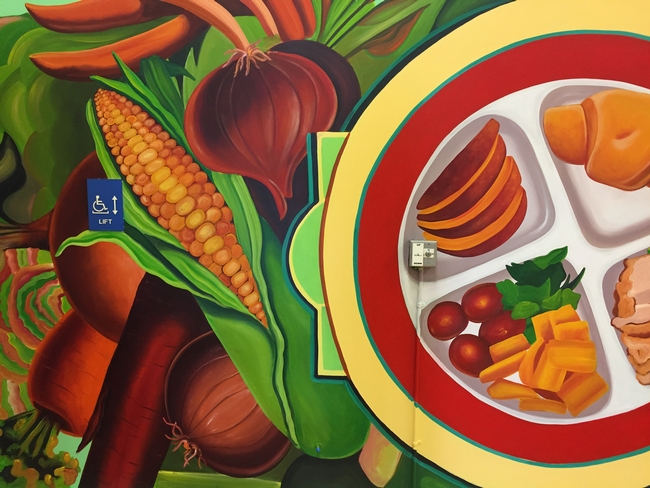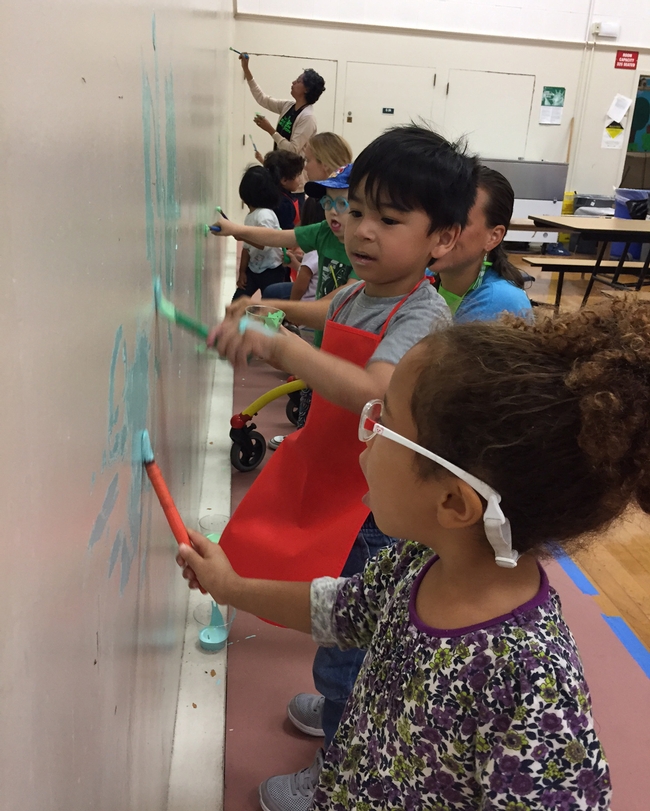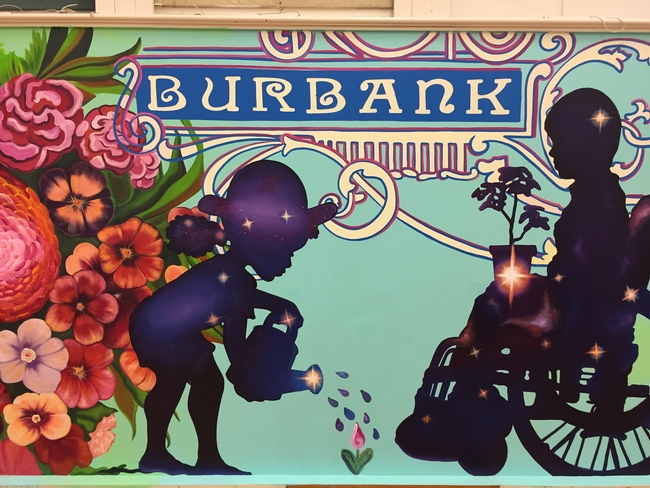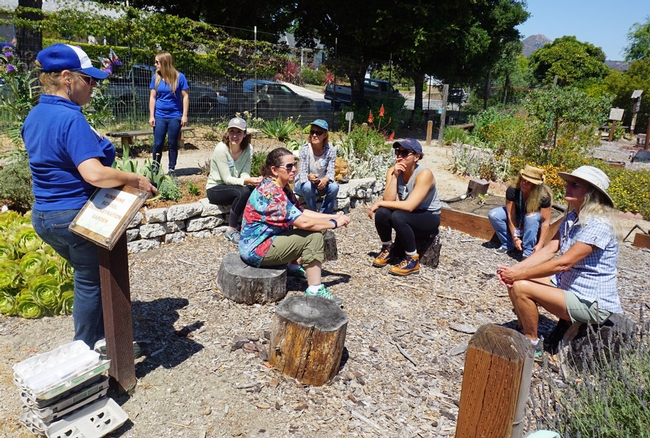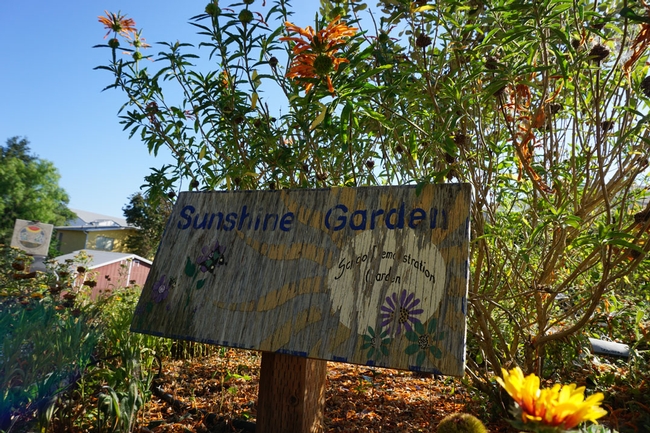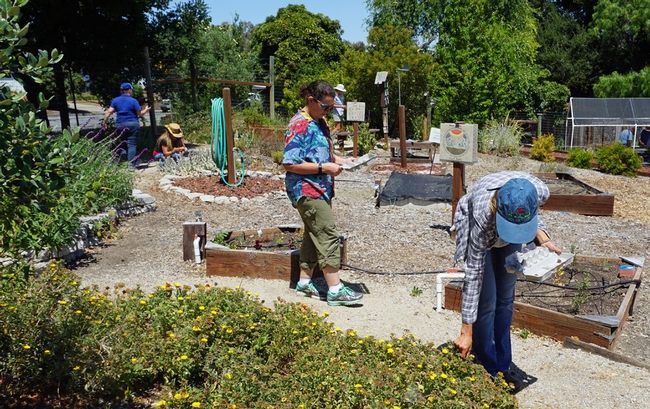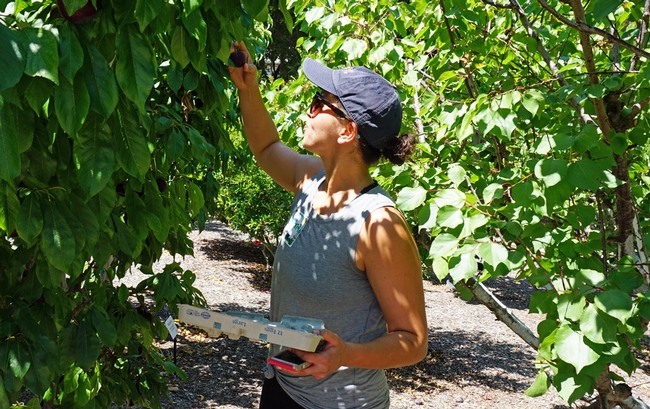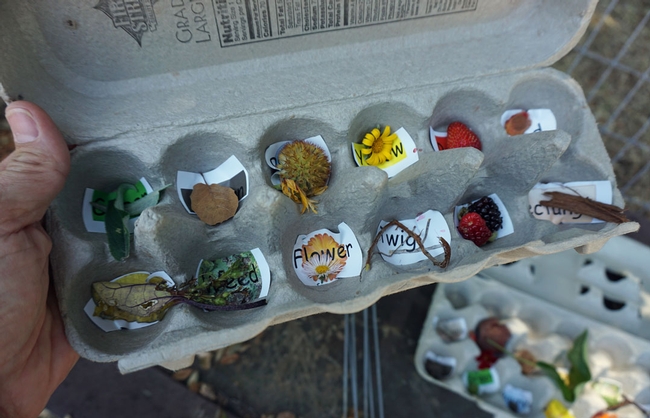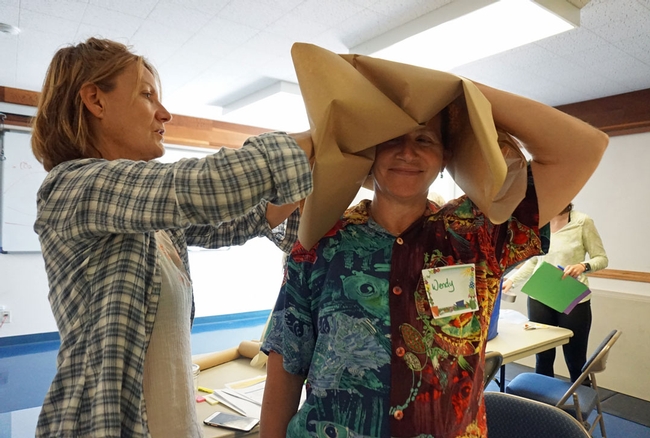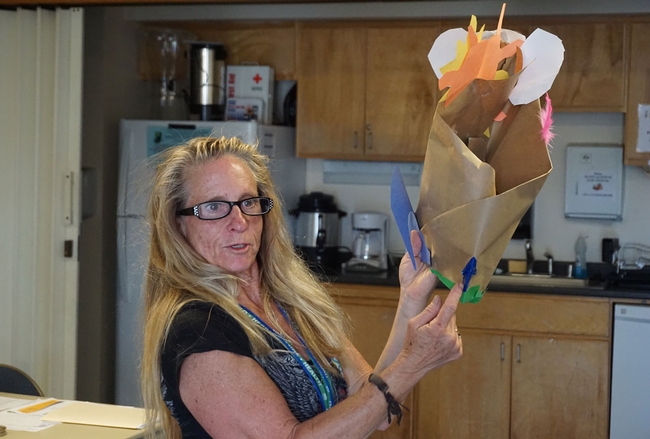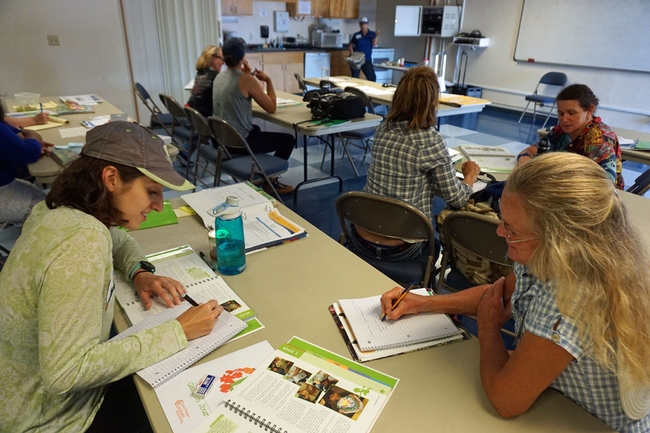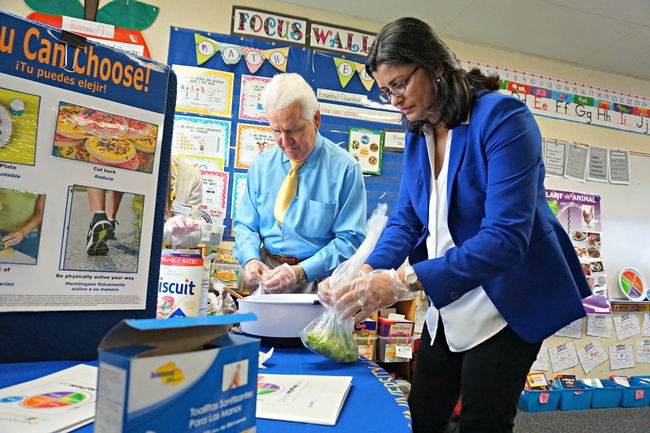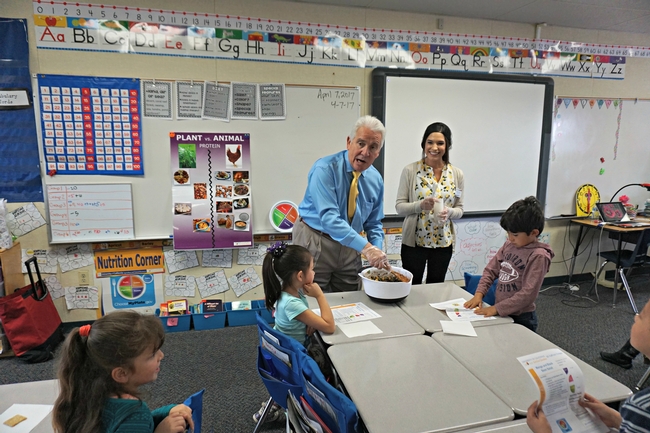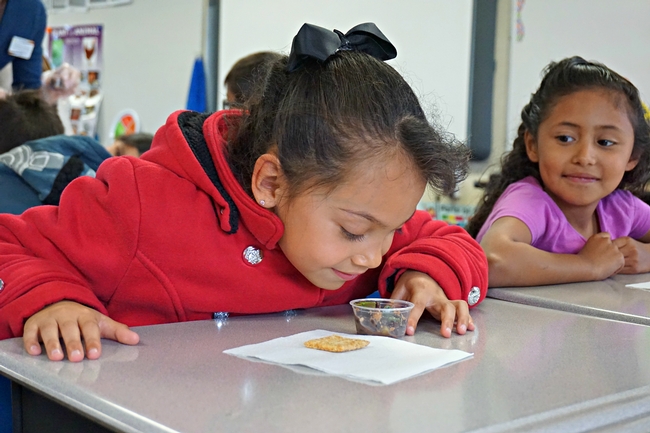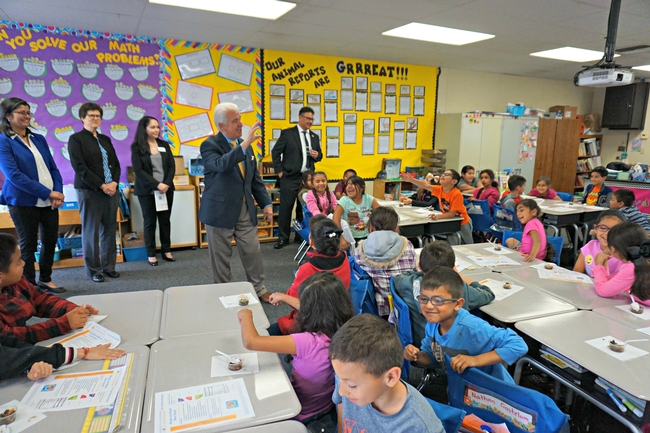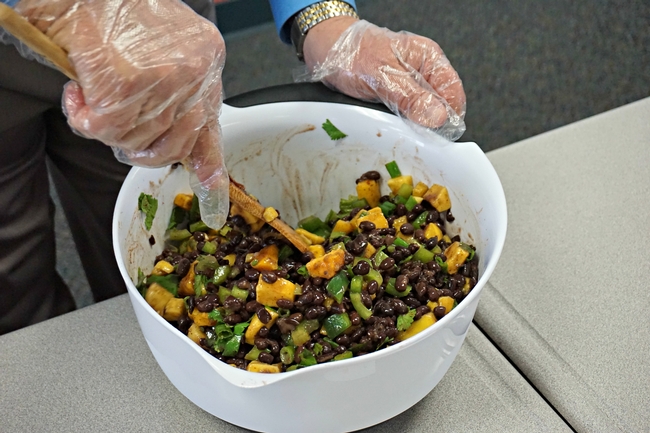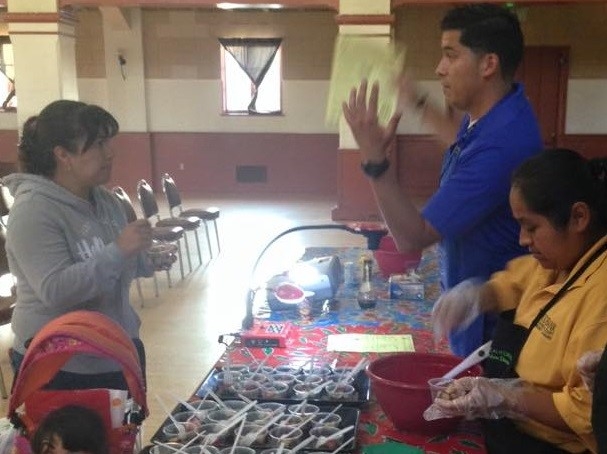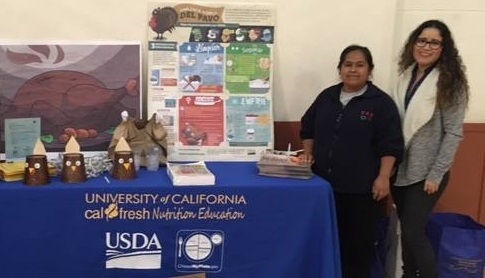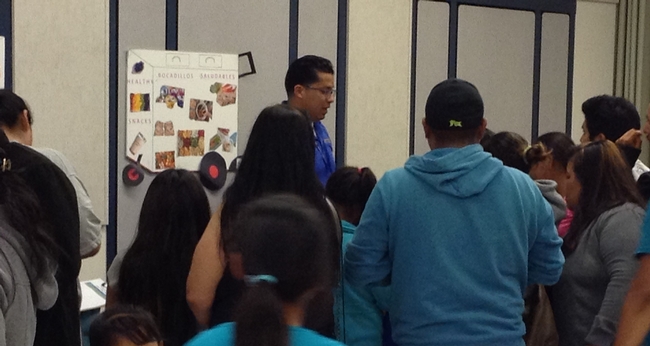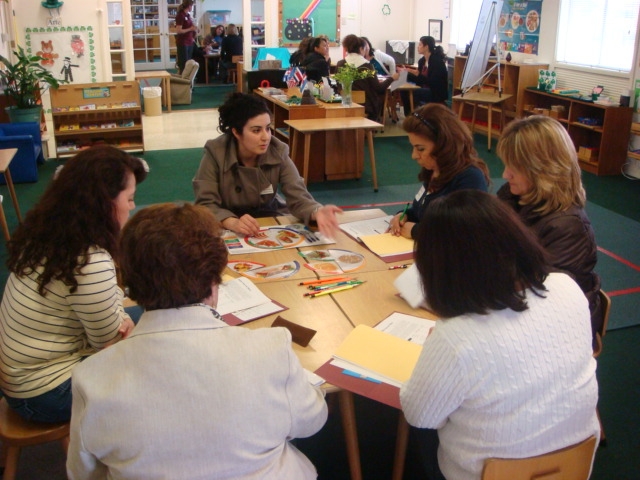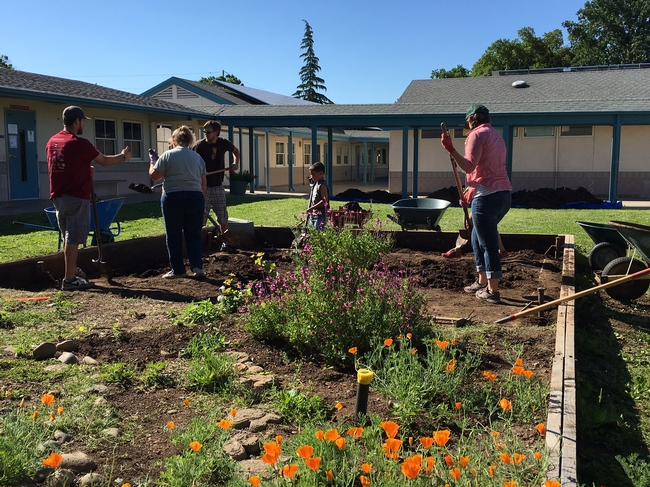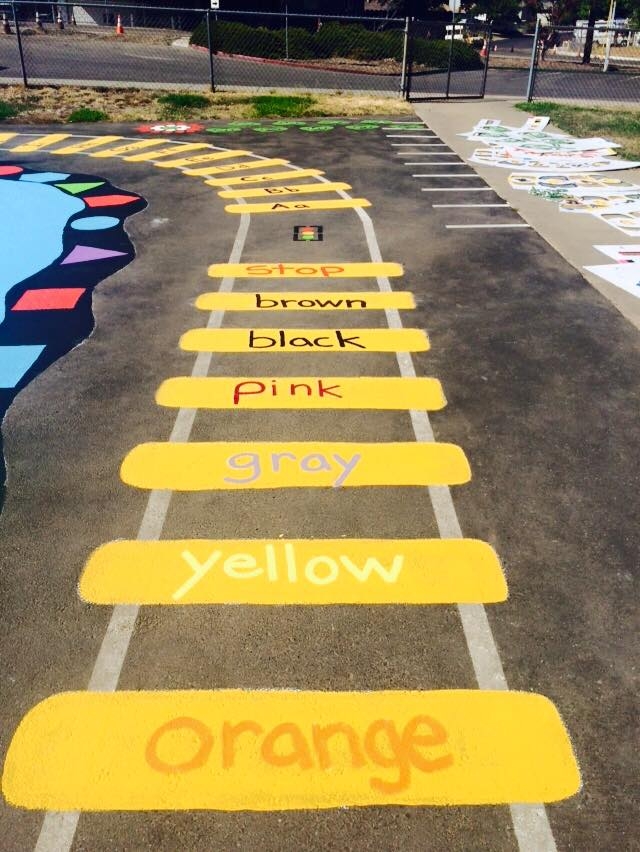Posts Tagged: UC CalFresh
New preschool food mural to encourage healthful eating to be unveiled Feb. 23
Students' surroundings can greatly impact their learning and health, research has shown.
In an effort to enhance nutrition, learning and health for these students in Oakland, the University of California Cooperative Extension, UC CalFresh Nutrition Education Program, Luther Burbank Preschool and Oakland Unified School District Early Childhood Education supported the installation of a mural that features silhouettes of children of different abilities among flowers, fruit and other foods cast in bold colors at Burbank Preschool.
“As a SNAP-Ed funded program, part of our work at UC Cooperative Extension is to support positive environmental change,” said Tuline Baykal, UC CalFresh Nutrition Education Program supervisor. “We believe that this mural in the cafeteria, with its beautiful and bold images of fruits and vegetables will encourage and remind students to make healthy choices and increase their consumption of tasty fruits and vegetables.”
Luther Burbank Preschool Center is an inclusive school serving the needs of over 200 students, ages 3 to 5, of varying abilities and needs. The Burbank preschool students and teachers helped paint the mural.
“Our students worked on the mural first, then David [Burke] completed it,” said Principal Tom Guajardo. “This project has been absolutely uplifting for our students, staff and parents. I say ‘uplifting' because I have heard comments like, “‘When I am feeling a little down or tired, I come and see the mural and I am immediately rejuvenated.' It has been a showcase when parents and visitors come to our school.”
On Friday, Feb. 23, at 2 p.m. - 3:30 p.m. the mural will be unveiled in the cafeteria of Luther Burbank Preschool at 3550 64th Avenue in Oakland. Parents, teachers and students are invited to a celebration to meet David Burke, the mural designer and well-known Bay Area artist. The UC CalFresh staff is planning some activity stations including a healthy cooking demonstration with free recipe books and a table where children can make “veggie faces” using fresh produce and hummus for dipping.
School gardens get new life from UC Cooperative Extension volunteers
When children grow their own fresh fruits and vegetables, they are much more likely to eat healthy food, so for decades California politicians, teachers and nutrition educators have advocated for a garden in every school. However, UC Cooperative Extension experts in Santa Barbara and San Luis Obispo counties found that garden care can dwindle over time.
“Students and their parents ‘age out' of their elementary schools,” said Shannon Klisch, UC CalFresh community education supervisor in San Luis Obispo and Santa Barbara counties. “The turnover in expertise and level of commitment can vary widely, leaving some schools with either weedy, abandoned vegetable patches, or no garden support at all.”
UCCE offers UC CalFresh, federally funded nutrition education for CalFresh recipients (formerly called Food Stamps). UC CalFresh nutrition educators in Santa Barbara and San Luis Obispo counties saw a need to mobilize highly trained community members who could develop, support, sustain and teach from school gardens. UC CalFresh joined with UC's 4-H Youth Development, Master Food Preserver, and Master Gardener programs to launch a pilot project called “UC Garden Nutrition Extenders.”
“We don't have enough staff to work the gardens in every school, so we've started recruiting and training volunteers,” said Lisa Paniagua, school garden sustainability coordinator for the UC Garden Nutrition Extender program in San Luis Obispo and Santa Barbara counties.
“By enlisting passionate volunteers, nutrition educators could significantly multiply the number of students who had access to school gardens, nutrition education, and training in science, technology, engineering, and math (STEM) in the garden,” said Katherine Soule, Ph.D., youth, families, and communities advisor in San Luis Obispo and Santa Barbara counties.
Klisch said UC Garden Nutrition Extenders are local members of their school communities.
“They are often parents, neighbors or staff and they have a personal investment in seeing the youth and the school environment flourish, which makes for a much more sustainable intervention and increases community capacity to sustain a garden program," she said.
Paniagua, Klisch, and Soule created a hybrid training program integrating volunteers and educators from UC CalFresh, UC Master Food Preservers, UC Master Gardeners and 4-H. They selected a 4-H gardening and nutrition curriculum written by researchers at Texas A&M AgriLife Extension, which includes engaging, student-centered, experiential learning while dividing time between the garden and the classroom. The curriculum reinforces goals in Common Core and Next Generation Science Standards, policies that guide public school teaching.
“Teachers will want to know we are familiar with curriculum standards. Applying them adds value to these classes,” Paniagua said.
In July, the third cohort of future UC Garden Nutrition Extender volunteers gathered at UC Cooperative Extension in San Luis Obispo to learn how they can help schools transform their gardens into fruitful learning activity centers for the students.
One member of the new cohort is Jill Marie, a certified Master Gardener in San Luis Obispo County.
“I live by a school and they have garden beds that are not kept up. I want to get involved and get to know the kids,” she said.
The volunteer teachers learn by conducting the indoor and outdoor curriculum activities and food demonstrations over a four-week period. Their first foray into the UCCE Sunshine School Demonstration Garden began with a mindfulness practice.
“Close your eyes, and just listen,” Paniagua instructed. A moment later she asked, “What did you hear?”
To encourage students to take a closer look at the garden, the class was sent out with egg cartons labeled for a 12-item scavenger hunt, and later asked to select one item to discuss. Reporting on topics are part of Common Core standards for students in third- through fifth-grades and creates discussion learning topics around science, math, engineering, art, and even poetry.
Back in the classroom, the trainees began work in pairs on the next lesson, “Know & Show Sombrero.” With paper, tape and a bag of craft supplies – balloons, ribbons, foam stickers and construction paper – the extenders made hats that represent everything a plant needs. One group used a yellow balloon to symbolize the sun, another had water drops raining down from the brim. A third group sprinkled glitter to represent the nutrients in the soil.
“Why are we putting these on a hat?” Paniaqua asked the class. “The exercise is useful for kinesthetic learners. It reinforces what they learn. At the end, we talk about it and develop conversation skills.”
The half-day session ended with a tasting of purple, yellow and orange carrots.
“In your journals, write words to describe the smell, sight, taste and feel of the three colors of carrots,” Paniagua said.
One of the volunteers Christina Lawson, director of nutrition for Coast Unified School District, laughed.
“We tried to serve purple carrots. Pfft. Zip,” she said. “I'm excited about this. If the kids try them before coming to the cafeteria, it would make my life so much easier.”
This project is funded through local grant awards from the National 4-H Council in collaboration with Lockheed Martin, and UC CalFresh Nutrition Education Program, which is a joint agreement among the U.S. Department of Agriculture/Food and Nutrition Service (USDA/FNS), the California Department of Social Services (CDSS) CalFresh branch, and the University of California Cooperative Extension (UCCE).
U.S. Congressman mixes up healthy food for UC nutrition education program
When United States Congressman Jim Costa learned about the federally funded nutrition education programs being offered in his district, he made plans to visit.
He wanted a first-hand experience with UC CalFresh, in which UC Cooperative Extension educators visit classrooms to share new foods, teach healthy eating strategies and demonstrate physical activity to children and low-income families.
In April, Congressman Costa not only met a group second graders at La Vina School in Madera County, their teacher Veronica Nava, and principal Jesus Navarro, he tucked in his tie and blended healthful ingredients like black beans, bell peppers and fresh mangos into the salad for the children to taste.
"I grew up in a rural area like you, and went to a wonderful school, like the one you're going to," Costa told the children. "You're lucky to have classes like this. It's so important to have good eating habits."
Costa said it was an honor to represent the second-graders and their parents in Washington, D.C.
"Can you do me a favor?" he asked. "I want you to be the best you can be. If you do well in what you do, America will be a better country."
Before leaving, Costa led the children in the 4-H Pledge:
I pledge:
My head to clearer thinking,
My heart to greater loyalty,
My hands to larger service,
My health to better living
for my club, my community,
my country and my world.
As a youth, Costa was a member of 4-H, a youth development program offered to children aged 9 to 19 by UC Cooperative Extension.
Congressman Costa mixed up the following recipe for the students:
Mango and black bean salad
Ingredients:
- 1 15-ounce can black beans, rinsed and drained
- 2 cups peeled, pitted and diced fresh mango (about 2 small mangos)
- 1/4 cup sliced green onions
- 1/4 cup chopped bell pepper
- 2 tablespoons lime juice
- 2 tablespoons 100% orange juice
- 1 tablespoon chopped fresh cilantro
- 1/2 teaspoon chili powder
- 1/4 teaspoon ground cumin
Mix together all ingredients in a large bowl. Salad may be served right away, but is best if covered and chilled for a least 1 hour for flavors to blend.
With nutrition education, a conversation may be more fruitful than a lecture
How do we support low-income Latino families with appropriate nutrition education that makes a difference in their lives? This was the question staff with the UC CalFresh Nutrition Education Program in San Luis Obispo and Santa Barbara counties were asking ourselves as we prepared for a monthly presentation at the THRIVE Healthy School Pantry in Santa Maria, California.
While many nutrition education programs work with local food banks to provide food demonstrations and nutrition information at supplemental food distribution sites, often, these classes can feel rushed. People are likely hurrying to pick up their food and so there is little time for more than just one-way communication where the educator provides the information and participants listen. Other times families may feel obligated to stay for the nutrition lesson in order to get their bag of food for their families.
This was the experience of our UC CalFresh Nutrition Educators delivering presentations and recipe demonstrations at the Healthy School Pantry food distribution. The Healthy School Pantry is a monthly food distribution focused on increasing food security and providing a strong social network for families to access a wide variety of community resources in English and Spanish.
When our nutrition education team started working at the Healthy School Pantry, the set-up was similar to a formal classroom environment where there was a teacher and students. The students (in this case, parents and families) would sit in rows, while the nutrition educator stood up front with a projector and microphone providing nutrition messages and a recipe demonstration using food from the pantry. We would include skills for preparing a recipe, and offer food samples and practical tips related to USDA's MyPlate.
After a few of these formal presentations, we began to notice that many parents were not interacting. We would ask for questions or suggestions on how participants could use this information or recipe, and most would respond with silence or politely, “todo está bien, gracias” [“everything is good, thanks”]. We also noticed other families would try to get past our table without making eye contact in order to leave. It became apparent that the families, for various personal or cultural reasons, did not feel comfortable participating and interacting in this formal class setting. Others just did not want to sit and listen for 15 to 30 minutes if they weren't sure that the information was going to be relevant to them.
Taking this into account, we decided to modify our approach. First, we got rid of the microphone and projector and moved our table into a high traffic area more integrated with the other community resources. Next, we changed our presentations to be more participatory and conversational. We set up our table with a colorful display and often a food sample, and then we walked around to the front of the table where we could greet and approach the families without a barrier. At one recent event, we brought an activity wheel and some basic physical activity equipment like jump ropes and stretchy bands. Parents walked right up and started to spin the wheel. When it landed on an exercise they would grab the equipment and start doing the activity and asking for tips. We were so surprised that they wanted to actually do the exercise right then and there and were really interested in talking to us about how they could get more physical activity in their busy lives. At one point we had a long line of parents waiting.
With these small changes, parents are provided more individual attention and an opportunity to have a conversation with the educator rather than feeling like they are students in a classroom. We are able to have more meaningful conversations and the parents are the ones approaching us and asking, “What recipe are you preparing today?” Parents are initiating the conversations and once we engage with them, they have many more questions about the ingredients, where to get them and the dialogue continues in a natural way that is meaningful and relevant to their lives. We are also able to clear up some misconceptions they may have. For example, we have heard many parents say they think that canned or frozen fruits are not healthy. Once we have their trust we are able to clear up the misinformation and let them know that canned and frozen produce can be an economical way to get more fruits and vegetables in their diet and, as long as there isn't added salt or sugar, can be just as healthy as fresh produce.
Within these conversations we take the opportunity to provide nutrition messages and tips, but we also have the opportunity to hear the parents' perspectives and comments. For example, one participant commented on a recipe they were demonstrating saying, “I really like the bean and garbanzo salad because it's nutritious, it has iron, vitamins and it is really easy to make.”
For our larger nutrition education program, this method has brought about additional benefits, including the opportunity to build stronger relationships with parents in the community and to talk to them about what our program is doing with their children during the school day. One mother who had approached our table several times in the past told us, "For me and my family, we have changed a lot about how we eat. We eat healthier and cheaper and we spend less on buying junk food. My children like what they have been taught in their classes by your program. That's why I like it because my children no longer like to eat things that are not healthy.”
Through these conversations, we see that families are leaving our table more informed and are more willing to seek out and approach our table the following month. The level and quality of interaction has increased and we are able to see and hear about the impact of our work and modify or change approaches based on the suggestions from the families.
We will continue with this successful education delivery model because we have seen and heard the satisfaction of the families and have received a lot of great feedback from parents. These small successes that are revealed to us through mutually respectful conversations keep us motivated to continue to provide services and promote a healthier community in a way that respects and values the experiences and knowledge that our families share.
The power of listening: Working for positive change in SNAP-Ed communities
Change takes time. There are frequently obstacles. But when it occurs, it can be satisfying.
This year, over 1,000 participant quotes from adults in the UC CalFresh Nutrition Education Program chart a course for change. In the food eaten, beverages consumed, or daily exercises undertaken, participants describe a desire to take a new approach, or be more conscious of the little daily decisions that can make all the difference in health.
In 2015, UC CalFresh programs were delivered in 891 sites. The majority of sites were education-oriented, with 78 percent being either public schools, preschools, adult education, or Head Start programs.
“This class changed eating habits for my family and friends." - Eating Smart Being Active class, Fresno County
“This class was very informative and it gave me tips and ideas on how to stay healthy, how to be active with our children and also great recipes! I enjoyed the class and will use their tips and ideas when thinking about my diet.” - Eating Smart Being Active class, Fresno County
Many quotes express thanks for a program that offers evidence-based curricula to help improve food resource management – budgeting for healthy food while on the Supplemental Nutrition Assistance Program (SNAP - formerly food stamps) or offer recipes that are tasty on a limited budget. Some quotes reflect on what was learned, and how to continue making decisions that “stay the course” in healthy food selection and preparation. And then, there are those that thank dedicated educators, such as this one:
“My first time here at the nutrition class was April 21. All of the information taught by Julie was important and I learned about eating better, making simple quick healthy meals. My granddaughter walked into the class for the last 10 minutes. She tasted some of the meal and she said, 'Yum -- very good. Grandma can we take some home.' I told her we had the recipe and she asked to go buy the ingredients and make some at home because it was very good and she wanted to eat more. She helped me buy ingredients and helped me prepare the meal. She ate 2 bowls …She wants to try other healthy meals. Thank you for providing this nutrition program to share with us!” - Plan Shop Save and Cook class, Kings County
Occasionally, there are inspirational stories that touch our hearts and make us re-dedicate ourselves each day to our work:
“My son is a kindergartener. He is also autistic with many sensory issues! He only eats certain things (like chips, pop tarts, canned soup and raviolis). The UC CalFresh educator, Mrs. Carter, came in to do a nutrition taste test with the students today and, to my surprise, my son ate edamame willingly. He said it was awesome! For me, this is a big milestone! It could be the start of trying new foods! I love this program… It's great for all kids!” - Healthy Happy Me class, Placer County
Moving from individual education to policy, systems and environmental change agents
In the past few years, UC CalFresh has increasingly worked on developing programs that have policy, systems and environmental change approaches. However, the stories told by participants illustrate the importance of building our programs from a foundation of direct education.
In this effort, UC CalFresh uses a “school as the hub” model in communities. Schools are seen as pivotal arenas for nutrition education that can also influence broader policy, systems, and environmental change. Through classroom nutrition education with students, and after-school programs for their families, schools generate the potential to reach different age groups in the community effectively.
A school is a powerful environment for learning, growth and community engagement - from school gardens to work with food service directors creating nutritious meals and enhancing the cafeteria environment, to playground activities with stenciling and murals reflecting healthy choices. Opportunities abound to generate change in perspectives on food choices, physical activity, and healthy living.
Assisting communities to build capacity for sustainable change
As we work with communities to build capacity in the areas described above, over time, a transition has the opportunity to take effect whereby local leaders - principals, teachers, parents, grandparents and students - motivated by the desire to embrace long-lasting healthy changes in their family and community - act as role models and change agents. This fundamental shift moves institutional initiative and strategies into “community-based systems change.” And the seeds of this change began with a lesson, a child, a parent, an educator … a simple quote.
This story en español.


